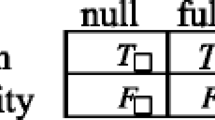Abstract
In this paper we describe the rules of the SET-VAR prover, which is an extension of resolution and which handles theorems in a subset of second-order logic. We also give example proofs using the system and show that the rules are sound. We conjecture that the prover, defined by these SET-VAR rules, is complete for a certain extension of first-order logic that includes many of the theorems of real analysis. We also describe an implementation of this SET-VAR prover and show proofs it derives (without human intervention) for a number of examples, including the intermediate value theorem. This system is based on an earlier ‘set variable’ prover, implemented in natural deduction. We also discuss the relationship between this method and circumscription.
Similar content being viewed by others
References
Bledsoe, W. W., ‘A maximal method for set variables in automatic theorem proving’,Proceedings of IJCAI-77, MIT, August 1977, pp. 501–510. AlsoMachine Intelligence 9, J. E. Hayes, D. Michie, L. I. Mikulich (Eds.), Chichester: Ellis Horwood Ltd. and New York: John Wiley, pp. 53–100 (1979).
Bledsoe, W. W., and Hines, L., ‘Variable elimination and chaining in a resolution-based prover for inequalities’,Proc. 5th Conf. on Automated Deduction, Bibel and J. Kowalski, (Eds.), New York: Springer-Verlag, pp. 281–292 (1990). Bledsoe, W. W. and Hines, L. M., ‘The STR + VE prover’, Univ. of Texas CS Dept. Memo ATP 94, August (1989).
Hines, L. M., ‘STR + VE-subset: The STR + VE subset prover’,Proc. 10th International Conf. on Automated Deduction, Berlin: Springer-Verlag, pp. 193–206 (1990).
Hines, L. M., ‘The central variable strategy of STR + VE’,Proc. 11th International Conference on Automated Deduction, New York: Springer-Verlag, pp. 35–49 (1992).
Bledsoe, W. W., ‘The paracompactness theorem’, Univ. of Texas CS Dept. Memo, ATP 96, June (1989).
Feng, Guohui, ‘Hand proofs of the compact-Hausdorff-regular theorem and the attains maximum theorem’, Univ. of Texas CS Dept. Memo, ATP 98, August (1989).
Bledsoe, W. W., and Bruell, P., ‘A man-machine theorem proving system’,AI J. 5 51–72 (1974). Bledsoe, W. W., and Mabry Tyson, The UT Interactive Prover. Univ. of Texas, Math. Dept. Memos ATP17A & ATP17B.
Minor, John T., ‘Proving a subset of second-order logic by reduction to first-order logic’, Dept. of Computer Science, UNLV, August 15 (1991). Accepted for publication byJ. Automated Reasoning.
Minor, John T., ‘Proving a subset of second-order logic with first-order logic proof procedures’, PhD Dissertation. Univ. of Texas at Austin, August (1979).
Behmann, H., ‘Beitrage zur Algebra der Logik, insbesondere zum Entscheidungsproblem’,Math. Annalen 86 163–229 (1922).
Ackermann, W.,Solvable Cases of the Decision Problem, North Holland (1954).
Baker-Plummer, D., and Bailin, S. C., ‘Z-match: For incrementally constructuing set instantiations’, Swarthmore College, Swarthmore, Penn., and CTA Inc., Rockville, Maryland (1991).
Andrews, P. B.,An Introduction to Mathematical Logic and Type Theory, Academic Press, 1986. Andrews, P. B., ‘On connections and higher order Logic’,J. Automated Reasoning 5, 257–291 (1989). Andrews, P. B.,et al., ‘The TPC theorem proving system’,Proc. CADE-10, Berlin: Springer-Verlag, pp. 641–642 (1990).
Kerber, M., ‘How to prove higher order theorems in first-order logic’,Proc. IJCAI-91, Morgan Kaufmann, pp. 137–142 (1991).
Robinson, J. A., ‘A machine oriented logic based on the resolution principle’,J. ACM 12 23–41 (1965).
Anderson, R., and Bledsoe, W. W., ‘A linear format for resolution with merging and a new technique for establishing completeness’,JACM 17 525–534 (1970).
Miller, Dale A., ‘Proofs in higher-order logic’, Dept. Computer and Information Science, Univ. of Pennsylvania, MS-CIS-83-87.
Feng, G., and Ballantyne, M., ‘Computing circumscription with SET-VAR methods’, EDS Technical Report AUS-1192-3, EDS Research, Austin lab (1992).
McCune, W.,OTTER 2 User's Guide, Argonne National Laboratory, ANL-90/9, 1990. W. McCune, ‘What's New in OTTER’. Mathematics and Computer Science Division, ANL/MCS-TM-153, Argonne National Laboratory (1992).
Wos, L., Overbeek, R., Lusk, E., and Boyle, J.,Automated Reasoning: Introduction and Applications, 2nd edn., New York: McGraw-Hill (1992).
Stickel, M. E., ‘A Prolog technology theorem prover: Implementation by an extended Prolog compiler’,J. Automated Reasoning 4 353–380, (1988).
Astrachan, O. L., and Loveland, D. W., ‘METEORs: High performance theorem provers using model elimination’,Automated Reasoning: Essays in Honor of Woody Bledsoe, Robert S. Boyer, (Ed.), Dordrecht: Kluwer Academic Publishers, pp. 31–59 (1991).
Lee, Shie-Jue, and Plaisted, D. A., ‘Eliminating duplication with hyper-linking strategy’,J. Automated Reasoning 9 25–42 (1992).
McCarthy, J., ‘Circumscription — a form of non-monotonic reasoning’,Artificial Intelligence 13 27–39 (1980).
Lifshitz, V., ‘Circumscription’, inHandbook of Logic in AI and Logic Programming (to appear). ‘Computing circumscription’,IJCAI, pp. 465–569 (1985).
Gabbay, D., and Ohlbach, H., ‘Quantifier elimination in second-order predicate logic’,Proc. 3rd International Conference on Principle of Knowledge Representation and Reasoning, 1992.
Bledsoe, W. W., ‘SET-VAR implementation’, Univ. of Texas at Austin CS Dept. Memo ATP 115, May (1993).
Author information
Authors and Affiliations
Additional information
EDS Research, 1601 Rio Grande, Austin, TX 78101, U.S.A.
Rights and permissions
About this article
Cite this article
Bledsoe, W.W., Feng, G. SET-VAR. J Autom Reasoning 11, 293–314 (1993). https://doi.org/10.1007/BF00881869
Received:
Accepted:
Issue Date:
DOI: https://doi.org/10.1007/BF00881869




